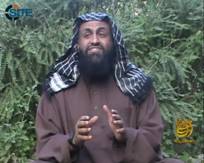 |
|
Khalid bin Abdul Rahman al Husainanan, from an As Sahab video. |
A Kuwaiti who was a prominent member of al Qaeda’s religious committee is thought to have been killed in a recent US drone strike in Pakistan’s tribal areas.
Two “contemporaries” of Khalid bin Abdul Rahman al Husainan, who is also known as a Abu Zeid al Kuwaiti, said he died in Afghanistan on Dec. 6, according to the SITE Intelligence Group. The two Kuwaitis, identified as Jaber al Jalahmah and Nabil Ali al ‘Awadhi, posted about Husainan’s death, but did not indicate how he died.
US intelligence officials told The Long War Journal that al Husainan was killed in a recent drone strike in Pakistan’s tribal areas. The US launched a drone strike in the Mir Ali area of North Waziristan on Dec. 6, as well as two strikes in in the Wana area of South Waziristan on Nov. 29 and Dec. 1. One intelligence official said al Husainan may have been moved to Afghanistan after being wounded in a drone strike.
Al Qaeda has not issued an official statement announcing Husainan’s death.
Al Husainan is a former imam in the Kuwaiti Endowments Ministry who “has appeared in dozens of as Sahab videos since August 2009, some lecturing on jihad and others speaking on Islam in general,” according to the SITE Intelligence Group. Al Husainan is “presented as an al Qaeda religious scholar,” SITE stated.
US intelligence officials told The Long War Journal that al Husainan was likely the successor to Abu Yahya al Libi as one of al Qaeda’s top religious scholars. Abu Yahya al Libi was killed in a US drone strike in June of this year.
Senior al Qaeda and jihadist leaders killed in drone strikes in Pakistan this year
In addition to Abu Yahya, three other high-value targets have been confirmed killed in the strikes in Pakistan this year. A Jan. 11 strike in Miramshah, the main town in North Waziristan, killed Aslam Awan, a deputy to the leader of al Qaeda’s external operations network.
On Feb. 8, the US killed Badr Mansoor, a senior Taliban and al Qaeda leader, in a strike in Miramshah’s bazaar. Mansoor ran training camps in the area and sent fighters to battle NATO and Afghan forces across the border, and linked up members of the Harakat-ul-Mujahideen with al Qaeda to fight in Afghanistan. Osama bin Laden described Mansoor as one of several commanders of al Qaeda’s “companies” operating in the tribal areas. He was later promoted to lead al Qaeda’s forces in the tribal areas.
And sometime earlier this year, a US drone strike killed Abu Usman Adil, the emir of the Islamic Movement of Uzbekistan. Adil succeeded Tahir Yuldashev, the co-founder of the IMU, who was killed in a drone strike in September 2009. Adil is credited with increasing the IMU’s profile in Pakistan and Afghanistan after the death of Yuldashev, US intelligence officials have told The Long War Journal. Whereas Yuldashev had been content with confining the group’s operations largely to Pakistan’s tribal areas, Adil pushed to expand operations in northern and eastern Afghanistan, as well as in the Central Asian republics.
Four senior jihadist leaders, including Abu Kasha al Iraqi and Fateh al Turki, are reported to have been killed in drone strikes in North Waziristan since the beginning of August, although their deaths have not been confirmed. Badruddin Haqqani, a top leader in the al Qaeda-linked Haqqani Network, is thought to have been killed in a drone strike in North Waziristan. Afghan Taliban spokesman Zabihullah Mujahid and a Haqqani Network spokesman denied reports that claimed Badruddin was killed, and said he “is in the country and he is occupied with his operational responsibilities.” Afghan, Pakistani, and US intelligence officials have said that Badruddin is dead.
And Emeti Yakuf, who is also known as Abdul Shakoor Turkistani, may have been killed in the Aug. 24 drone strike in North Waziristan’s Shawal Valley that hit a training camp. Yakuf directs al Qaeda operations in Pakistan’s tribal areas.








11 Comments
Another blow to the al Qaeda braintrust!
From Dawn via NBC:
http://dawn.com/2012/12/08/senior-al-qaeda-leader-killed-in-drone-strike-in-pakistan/
The article states the targeted AQ leader was a probable successor to Ayman al-Zawahiri.
Glad this one is dead.
Always good to hear when one of them bites it. Only hope Ayman al-Zawahiri himself is added to that list sooner rather than later. Mullah Omar too, although I’m no longer even convinced that we’re seriously trying to kill or capture him.
Is there any open source data about the information or results that were achieved from processing the Intel from the OBL compound?
KaneKeiser
I would say Mullah Omar is looked after by the Pak ISI re future negotiations and Zawahiri is either in an ISI safehouse or in a safehouse in Iran.
Either way both Pakistan and Iran are enemies and need to be recognised as though by the public in the West.
@KaineKaizer
That birthmark, or whatever it is on AaZ’s forehead does make a perfect target. If we could just put a laser on that spot long enough for a Hellfire to find it’s mark.
like many others whose photo’s & video’s have been ‘posted’ Khalid bin Abdul Rahman al Husainan has the look of ‘one’ on opiates & other chemicals/substances
@Witchdoctor That’s definitely no birthmark. A lot of crazy fundies like him have literal dents in their foreheads from years of banging their foreheads into the ground during prayers. We should help him dent the rest of his body with a well-placed hellfire missile!
That would be a yes NEXT!
Witch Doctor,
Actually it is a zebibat salah (prayer raisin) which is from hitting your head to the floor in prayer. It is a pride symbol for (primarily) older Egyptian men. He wants you to know that he prays a lot. They seem to think that God looks at a person’s face and not his heart.
@ Stephanie. Thank you for making me a smarter man.